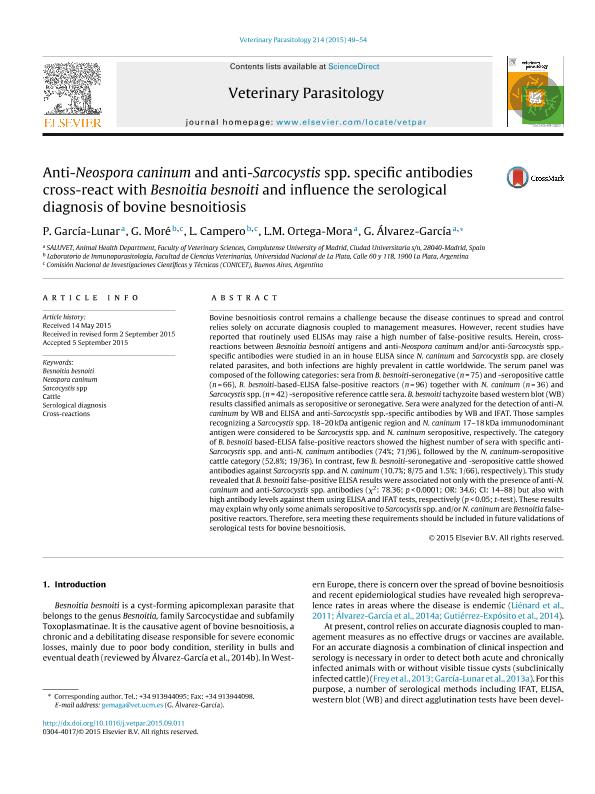Mostrar el registro sencillo del ítem
dc.contributor.author
García Lunar, P.
dc.contributor.author
Moré, Gastón Andrés

dc.contributor.author
Campero, Lucía María

dc.contributor.author
Ortega Mora, L. M.
dc.contributor.author
Álvarez García, G.
dc.date.available
2018-07-30T17:59:55Z
dc.date.issued
2015-11
dc.identifier.citation
García Lunar, P.; Moré, Gastón Andrés; Campero, Lucía María; Ortega Mora, L. M.; Álvarez García, G.; Anti-Neospora caninum and anti-Sarcocystis spp. specific antibodies cross-react with Besnoitia besnoiti and influence the serological diagnosis of bovine besnoitiosis; Elsevier Science; Veterinary Parasitology; 214; 1-2; 11-2015; 49-54
dc.identifier.issn
0304-4017
dc.identifier.uri
http://hdl.handle.net/11336/53436
dc.description.abstract
Bovine besnoitiosis control remains a challenge because the disease continues to spread and control relies solely on accurate diagnosis coupled to management measures. However, recent studies have reported that routinely used ELISAs may raise a high number of false-positive results. Herein, cross-reactions between Besnoitia besnoiti antigens and anti-Neospora caninum and/or anti-Sarcocystis spp.-specific antibodies were studied in an in house ELISA since N. caninum and Sarcocystis spp. are closely related parasites, and both infections are highly prevalent in cattle worldwide. The serum panel was composed of the following categories: sera from B. besnoiti-seronegative (n=75) and -seropositive cattle (n=66), B. besnoiti-based-ELISA false-positive reactors (n=96) together with N. caninum (n=36) and Sarcocystis spp. (n=42) -seropositive reference cattle sera. B. besnoiti tachyzoite based western blot (WB) results classified animals as seropositive or seronegative. Sera were analyzed for the detection of anti-N. caninum by WB and ELISA and anti-Sarcocystis spp.-specific antibodies by WB and IFAT. Those samples recognizing a Sarcocystis spp. 18-20kDa antigenic region and N. caninum 17-18kDa immunodominant antigen were considered to be Sarcocystis spp. and N. caninum seropositive, respectively. The category of B. besnoiti based-ELISA false-positive reactors showed the highest number of sera with specific anti-Sarcocystis spp. and anti-N. caninum antibodies (74%; 71/96), followed by the N. caninum-seropositive cattle category (52.8%; 19/36). In contrast, few B. besnoiti-seronegative and -seropositive cattle showed antibodies against Sarcocystis spp. and N. caninum (10.7%; 8/75 and 1.5%; 1/66), respectively). This study revealed that B. besnoiti false-positive ELISA results were associated not only with the presence of anti-N. caninum and anti-Sarcocystis spp. antibodies (χ2: 78.36; p<0.0001; OR: 34.6; CI: 14-88) but also with high antibody levels against them using ELISA and IFAT tests, respectively (p<0.05; t-test). These results may explain why only some animals seropositive to Sarcocystis spp. and/or N. caninum are Besnoitia false-positive reactors. Therefore, sera meeting these requirements should be included in future validations of serological tests for bovine besnoitiosis.
dc.format
application/pdf
dc.language.iso
eng
dc.publisher
Elsevier Science

dc.rights
info:eu-repo/semantics/openAccess
dc.rights.uri
https://creativecommons.org/licenses/by-nc-nd/2.5/ar/
dc.subject
Besnoitia Besnoiti
dc.subject
Cattle
dc.subject
Cross-Reactions
dc.subject
Neospora Caninum
dc.subject
Sarcocystis Spp
dc.subject
Serological Diagnosis
dc.subject.classification
Otras Ciencias Veterinarias

dc.subject.classification
Ciencias Veterinarias

dc.subject.classification
CIENCIAS AGRÍCOLAS

dc.title
Anti-Neospora caninum and anti-Sarcocystis spp. specific antibodies cross-react with Besnoitia besnoiti and influence the serological diagnosis of bovine besnoitiosis
dc.type
info:eu-repo/semantics/article
dc.type
info:ar-repo/semantics/artículo
dc.type
info:eu-repo/semantics/publishedVersion
dc.date.updated
2018-07-30T13:37:07Z
dc.journal.volume
214
dc.journal.number
1-2
dc.journal.pagination
49-54
dc.journal.pais
Países Bajos

dc.journal.ciudad
Amsterdam
dc.description.fil
Fil: García Lunar, P.. Universidad Complutense de Madrid; España
dc.description.fil
Fil: Moré, Gastón Andrés. Universidad Nacional de La Plata. Facultad de Ciencias Veterinarias. Departamento de Epizootiología y Salud Pública. Laboratorio de Inmunoparasitología; Argentina. Consejo Nacional de Investigaciones Científicas y Técnicas; Argentina
dc.description.fil
Fil: Campero, Lucía María. Universidad Nacional de La Plata. Facultad de Ciencias Veterinarias. Departamento de Epizootiología y Salud Pública. Laboratorio de Inmunoparasitología; Argentina. Consejo Nacional de Investigaciones Científicas y Técnicas; Argentina
dc.description.fil
Fil: Ortega Mora, L. M.. Universidad Complutense de Madrid; España
dc.description.fil
Fil: Álvarez García, G.. Universidad Complutense de Madrid; España
dc.journal.title
Veterinary Parasitology

dc.relation.alternativeid
info:eu-repo/semantics/altIdentifier/doi/http://dx.doi.org/10.1016/j.vetpar.2015.09.011
dc.relation.alternativeid
info:eu-repo/semantics/altIdentifier/url/https://www.sciencedirect.com/science/article/pii/S0304401715300200
Archivos asociados
